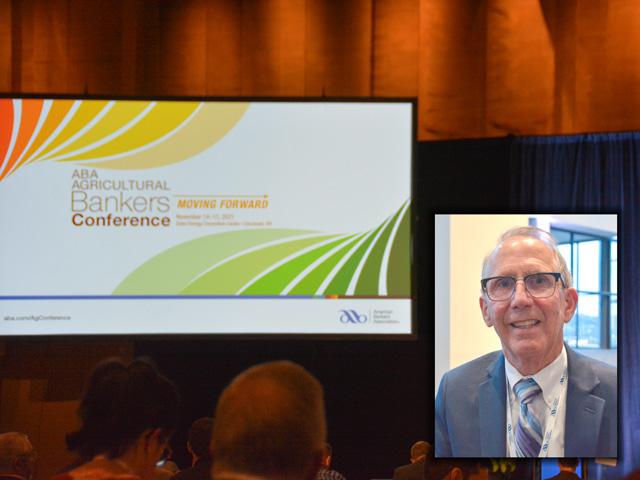Bankers Upbeat on Farm Income Prospects
Ag Bankers See Stronger Income for Borrowers; Also Note Increasing Land Prices, Inflation, Higher Input Costs
CINCINNATI (DTN) -- Despite concerns about inflation, agricultural bankers overall are more upbeat about the profitability they are seeing from their loan customers than in the past five years.
The ABA and Federal Agricultural Mortgage Corp. (Farmer Mac) released the results of a survey Tuesday showing agricultural lenders expect 80% of their borrowers will be profitable in 2021, and 70% of those borrowers should be profitable through 2022 as well. The report was released at the ABA's Agricultural Bankers Conference in Cincinnati.
ABA noted the results mark the first time since ABA and Farmer Mac began the joint survey in 2016 that a majority of ag lenders who responded, 69.7%, reported overall farm profitability increased in the prior year. This was largely due to government support, which lenders estimate accounted for 38% of borrowers' net income.
USDA's latest forecast for farm income, released in September, forecast net farm income up 19.5% for 2021 at $113 billion nationally, the highest since 2013.
Dave Coggins, executive vice president for Investors Community Bank in Manitowoc, Wisconsin, told DTN that ag bankers are seeing stronger 2021 incomes and balance sheets from their customers. Agricultural bankers also have weathered the pandemic and integrated more technology in their banks to meet customer needs since COVID-19 began.
"There's a general sense that most of the commodity groups are looking better," said Coggins, who is chairman of the Ag Bankers Conference this year.
P[L1] D[0x0] M[300x250] OOP[F] ADUNIT[] T[]
Coggins added there are some concerns about the price of inputs. "When you look at 80% of farm inputs have some tie to energy, oil and gas, that's always a concern. There's certainly plenty of concern about inflation. There are always storm clouds on the horizon, whether it's economic trade issues or weather issues."
Beyond input prices, Coggins said bankers have been highlighting their worries about the national debt as increased federal spending raises inflationary concerns that could drive up interest rates. "That, of course, affects land values. Those land values now are being driven up by a lot of money that's available right now."
While positive about their customers' chances for profitability, inflation has become a key risk for lenders in 2021, the ABA survey highlighted. Almost 40% of respondents listed inflation as their top concern and 70% listed it in their top three.
Bankers also reported significantly higher land values in 2021, a 5.3% increase on average, as a trend that lenders do not see reversing in 2022.
"The reported increase in farmland values is additional evidence of the improved economic conditions experienced by farmers and ranchers in 2021," said Farmer Mac Chief Economist Jackson Takach. "Lenders reported strong gains in most regions in 2021 and approximately 79% of respondents expect additional gains of 3% or more in 2022. Land is the single largest asset class on farm balance sheets, so the asset appreciation provides additional equity to many producers across the rural landscape."
Agricultural bankers also pointed out they are facing more competition from other lenders for their customers' business. More than 50.4% of survey respondents ranked competition among their top two concerns, up 13 percentage points from last year. The majority (82.3%) ranked the Farm Credit System as their number one competitor for agricultural loans. ABA continues to focus on what bankers see as unfair competition from Farm Credit and credit unions in general because those institutions do not pay income taxes but also compete directly with banks for customers.
For the first time in more than five years, lenders observed a pullback in demand for agricultural production loans, underscoring elevated concerns for loan demand given strong lender competition in 2021. One factor leading to lower loan demand was increased reliance of producers on government payments. Still, ag lenders also were more aggressive in 2021 signing up their customers for programs such as the Small Business Administration's Paycheck Protection Program (PPP). Ag lenders made more than 600,000 PPP loans in 2021, up 41% from 2020, worth more than $16.4 billion.
FSA LOANS
At the Ag Bankers Conference on Monday, Zach Ducheneaux, administrator for USDA's Farm Service Agency, spoke on a panel with other FSA loan officers about the agency's loan guarantee program and operating loans. With the rising costs of fertilizer and other products, Ducheneaux said FSA needs to be flexible with producers and bankers willing to use FSA's loan guarantee program.
"We have to push the boundaries of what we are already doing," he said. Ducheneaux cautioned producers could continue seeing challenges tied to the pandemic. "We might not be at the tail end of this like we all at hoped." He added, "Producers have plenty of risk to mitigate, partly due to weather and markets."
While noting the need for USDA to be flexible to serve producers, Ducheneaux also noted there are limits to what FSA can do with direct loans or guarantees due to limits on total loan dollars the agency can back. That requires the banks and other institutions to carry the load on operating loans.
"We don't have the capacity to serve all of the producers who will need it," he said.
The full ABA/Farmer Mac survey can be found at: https://www.aba.com/…
Chris Clayton can be reached at Chris.Clayton@dtn.com
Follow him on Twitter @ChrisClaytonDTN
(c) Copyright 2021 DTN, LLC. All rights reserved.




